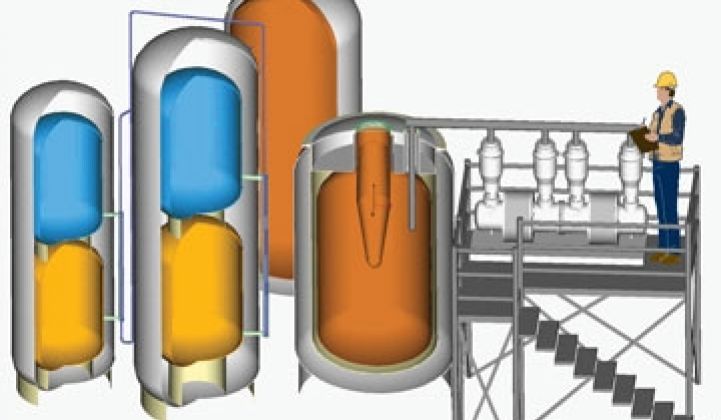Abu Dhabi—The novel ideas for solar thermal technology just keep coming.
Solar Fusion Power will in nine months try to show off a prototype of a solar thermal power system that combines unusually shaped heliostats, a beam down heat transfer system, calcium and hydrogen. Like I said, it's unusual.
However, if the system can prove to work, it could raise the bar for efficiency for solar thermal systems. Most advanced solar thermal systems can convert 20 percent plus of the energy they harvest into electricity. Solar Fusion claims it can approach the 50 percent mark. The company is exhibiting at the World Future Energy Summit taking place this week in Abu Dhabi. EMC Solar, an Australian PV integrator, has invested in it, but it is seeking other investors. The test will occur in Perth.
How does it work? The company wants to build mirrored solar thermal collectors (heliostats) that are shaped somewhat like flowers. The heat from the collectors is then beamed to a quartz lens sitting on a pole that extends approximately twenty feet from the center of the heliostat flower and sort of resembles a stamen. The heliostat flower measures around 10 meters in diameter and covers about 50 square meters in area.
The quartz lens then focuses the heat on a mirror right above it. The small mirror then directs heat to a mirrored hemisphere on a tower. The hemisphere then condenses the heat from a field of the heliostat flowers and directs it in a beam toward a collector on the ground.
"The down beam is about a megawatt," said Wayne Bliesner, the inventor.
So what happens next? The heat passes into a chamber of liquid calcium simmering at 800 degrees Celsius. A stream of pressurized hydrogen is introduced and the temperature is raised to 1000 Celsius. The increased temperature turns the liquid calcium into calcium hydride, a reaction that generates a tremendous amount of heat, Bliesner said. That heat is then fed into a specialized Stirling Engine designed by Solar Fusion and then converted to electricity.
The calcium-to-calcium hydride reaction becomes self-sustaining, he added, because calcium hydride is heavier. It sinks to the bottom of the tank, allowing more fresh liquid calcium to rise and mix with hydrogen.
"The reaction keeps going until you run out of calcium," he said.
But wait! There's more. The calcium hydride reaction is reversible by easing off the pressure inside the tank. The tank fills again with liquid calcium and the hydrogen can be piped out to start another cycle of calcium hydride reactions. Any excess heat can be stored in other tanks for producing power at night.
If it works on a large scale, the system has definite advantages. The heat transfer fluid sits on the ground, similar to a ground-based fluid system shown off by Abu Dhabi's Masdar Institute earlier this week. Because fluids don't have to be pumped up into a tower, the system requires less energy. (Israel's Weizmann Institute also has a prototype beam down system.) And of course it raises the efficiency.
"The hardest part was the container" of the liquid calcium, he said. "Molybdenum was the only metal that would hold it and it is not easily manufacturable. To cut costs, Solar Fusion might place a ceramic insert into the chamber.
The heliostat mirrors are also curved, which means they will be more expensive to make than the flat heliostats used by more established companies like BrightSource Energy and eSolar. BrightSource has also produced more extensive data on its thermodynamics.



